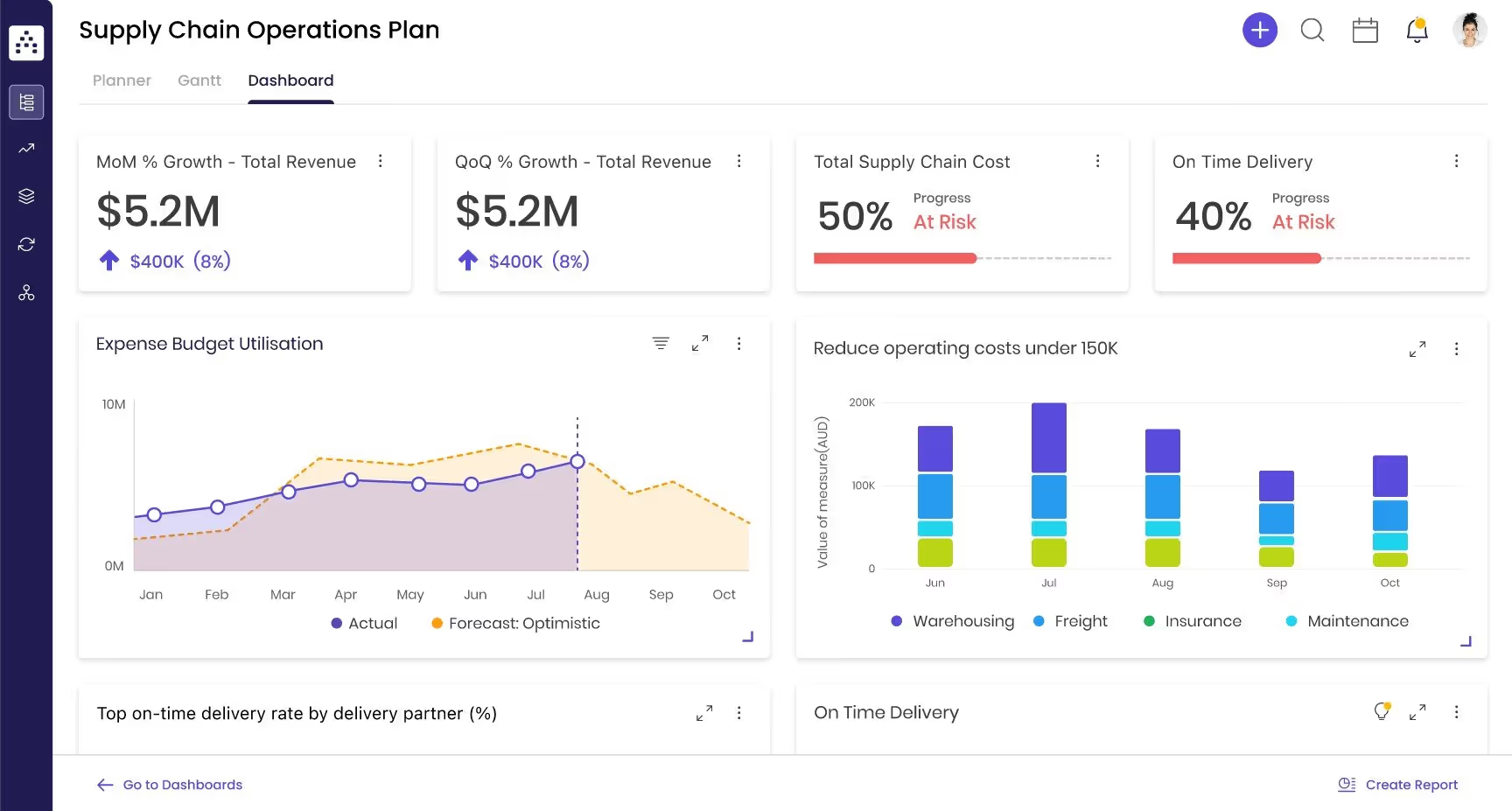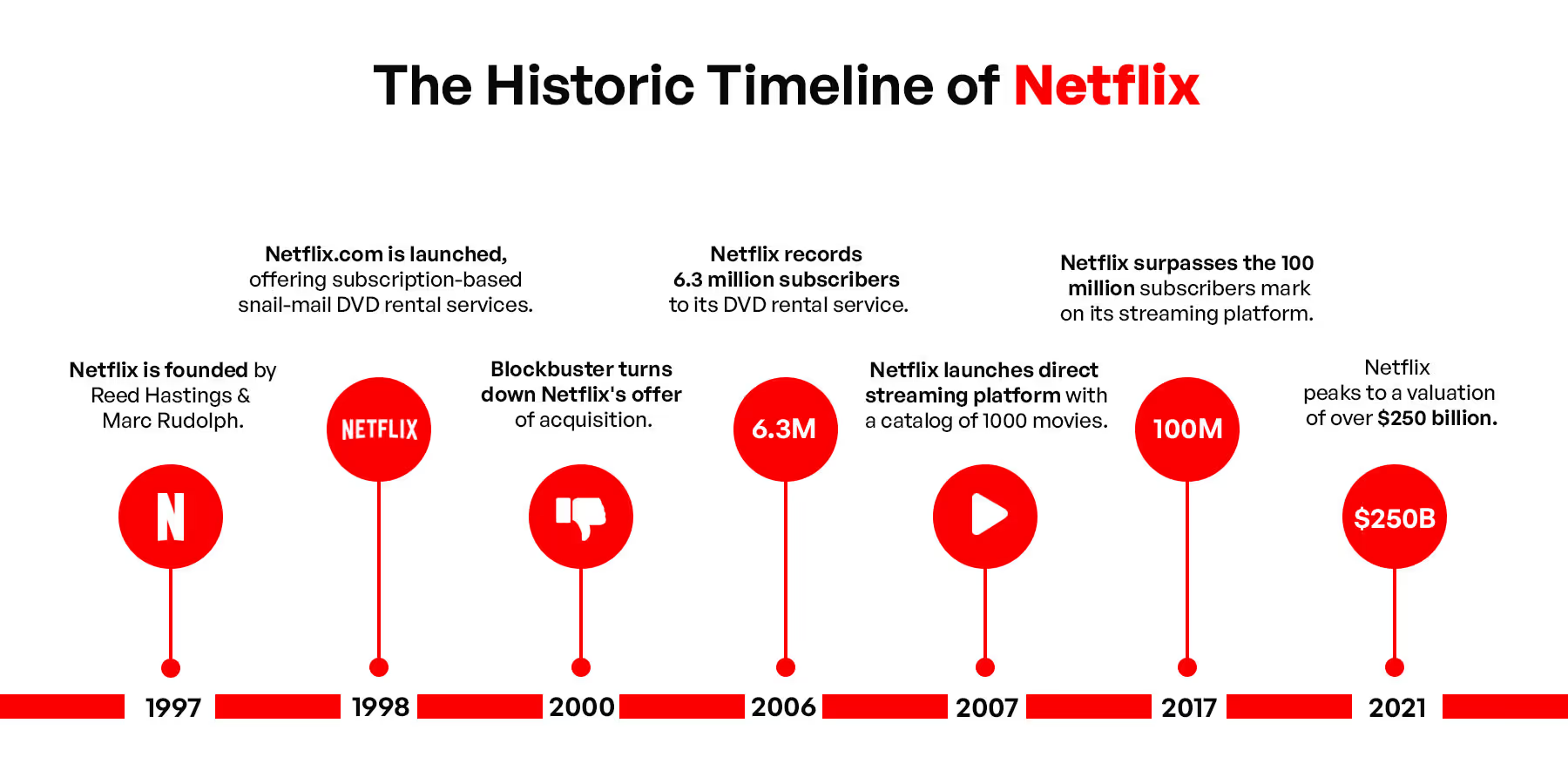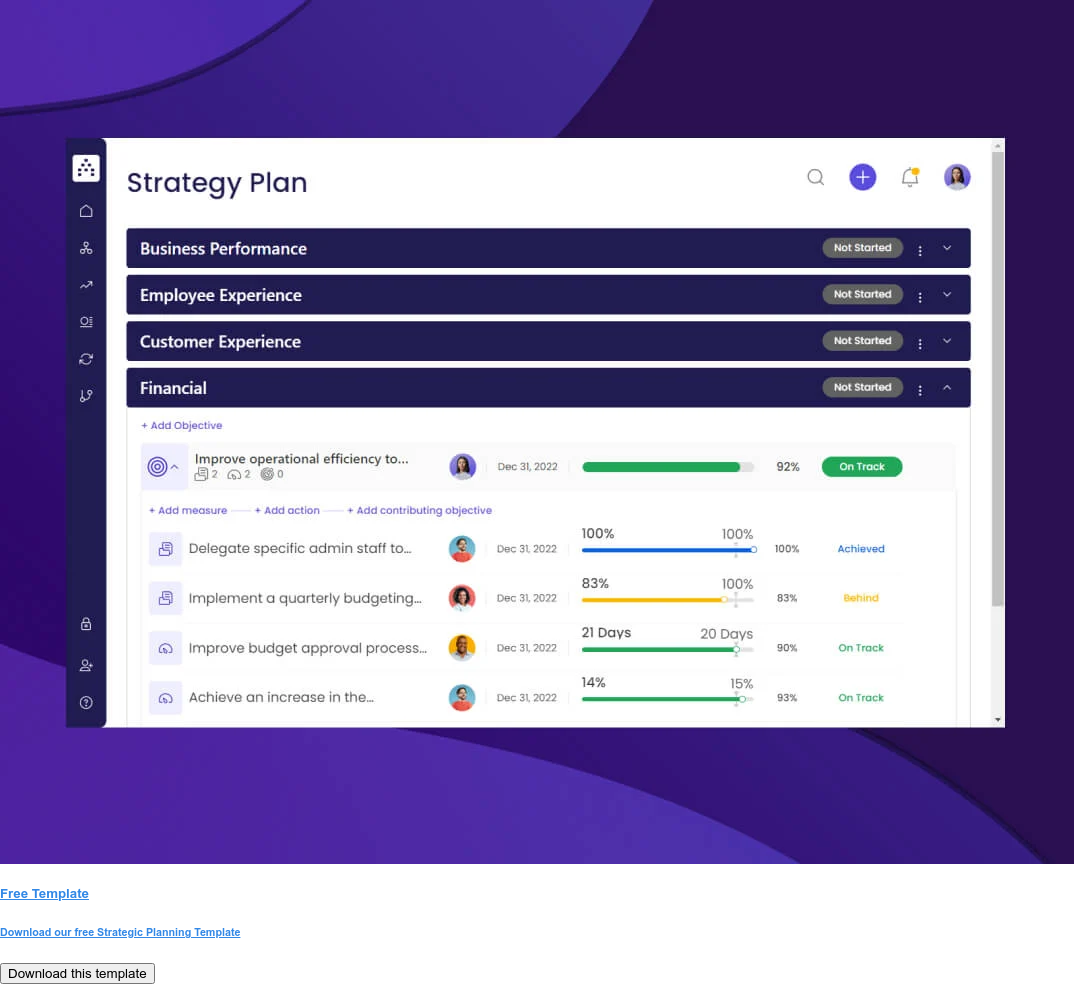Tired of being stuck in a cycle of putting out fires and feeling like you're not using your resources effectively? It's time to revolutionize your approach to strategic planning to ensure successful strategy execution.
Did you know that only about 52% of companies successfully implement their strategic plans? That's a low number, and it means that businesses are losing out on big bucks due to a completely outdated approach that separates strategic planning from execution and tracking. Spending months or even years on the planning process alone and expecting execution and tracking to magically fall into place is a recipe for failure.
So, what's the key to success? It's about recognizing that strategic planning is not a one-time isolated activity but an iterative approach that’s part of a holistic process.
It's all about integrating iterative strategic planning into your organization's DNA! In this article, we'll help you evolve from a traditional, rigid strategic planning process to a dynamic and iterative one that will empower you to achieve your organization's goals effectively.
What Is A Strategic Planning Process?
The strategic planning process is an iterative and adaptable approach to setting long-term goals and objectives for your organization. Gone are the days of a linear multi-step process that takes forever. Instead, we embrace a holistic view that encompasses strategic planning, tracking, adapting, and executing concurrently.
This transformative approach allows you to navigate uncertainty and gain a sustainable competitive advantage.
Why Does Your Business Need A Strategic Plan?
A strategic plan serves as a vital roadmap for any business, guiding it toward long-term success. Without a clear and comprehensive plan, your business lacks direction and struggles to make progress. By embracing a strategic plan that considers the simultaneous nature of planning and execution, you can proactively anticipate changes, seize opportunities and reach your objectives.
Businesses that neglect strategic planning are often caught up in the whirlwind of urgent day-to-day operations or are lost navigating a path that leads nowhere. However, it's crucial to avoid falling into the trap of overplanning.
While having a strategic plan is essential, spending excessive time crafting a "perfect plan" that delves into every detail can be counterproductive. The world changes rapidly, and by the time you're ready to execute, the context you considered during planning may no longer be relevant. Besides, an excessively granular and rigid plan is prone to collapse at the slightest deviation from expectations.
With a comprehensive and agile approach to strategic planning, you gain several advantages:
- Allows you to prioritize resources and efforts, focusing on actions that truly matter
- Effective decision-making to evaluate opportunities and assess risks
- Adapt and pivot quickly when something changes or is not working
By embracing an iterative strategic planning process, you'll equip your organization with the tools necessary to thrive in an ever-evolving business landscape.
How To Evolve Your Strategic Planning Process
To move from a rigid strategic planning process to an iterative one, organizations need to embrace a more dynamic and flexible approach. Rather than viewing strategic planning as a one-time, linear process, it should be seen as an ongoing and iterative cycle that allows for continuous improvement and adaptation. By incorporating the following recommendations, organizations can transition towards a more iterative strategic planning process.
Streamline the pre-planning stage
Before diving into the strategic planning process, it's essential to streamline the pre-planning stage to expedite the process. However, let's debunk the misconception that pre-planning requires extensive time and effort. In reality, a simplified approach is key.
- Set clear objectives for the planning process: Avoid getting caught up in unnecessary details and focus on the core elements that will drive your organization forward.
- Don’t spend excessive time gathering data: Prioritize the most relevant and impactful information and create a flexible planning timeline that allows for adjustments as you progress.
- Keep it concise, open, and transparent: Effective communication is crucial, but avoid getting bogged down in lengthy protocols. Instead, promote ongoing dialogue to maintain progress awareness.
- Don’t rely solely on pre-determined strategic frameworks: Encourage teams to use a combination of frameworks and methodologies that align with your organization's specific needs.
Continuously assess your strategic position
Conducting a one-time analysis of your organization's strengths, weaknesses, opportunities, and threats (SWOT) doesn’t make sense. To truly understand your strategic position, a continuous evaluation is necessary.
While SWOT analysis provides a foundation, don't limit yourself to it. Embrace a broader range of assessment tools and techniques. Regularly revisit your company's mission, vision, and values, ensuring their alignment with your evolving strategy.
Take a holistic view of the business landscape and competitors, considering frameworks like PESTLE, Porter's Five Forces, Gap Analysis, or the McKinsey 7S Model. This comprehensive evaluation will enable you to identify emerging trends, anticipate disruptions, and capitalize on new opportunities.
👉 Get your free internal analysis template here.
Build your unique strategic planning model
Every organization is unique, so why should they all adhere to the same rigid strategic planning models?
No single model can fully capture the complexity of your organization's strategy. Instead of getting tangled in unnecessary complexity or rigid governance structures, opt for a simpler and more flexible approach.
Consider strategic planning models as valuable starting points, but don't let them restrict you. Choose what aligns best with your organization's needs and objectives. If a model falls short, modify and adapt it to suit your organization rather than trying to force your organization into a predefined model.
Do you find value in different parts of various models? Feel free to mix and match them to develop a strategy that truly fits your organization.
Here’s what we like the most about the following models that can inspire you:
- The Balanced Scorecard focuses on four perspectives (finance, customers, internal business processes, learning and growth) and connects them with strategic objectives, projects, and key performance indicators (KPIs). Tip: If there are other perspectives that are more important to your organization, feel free to customize the model and incorporate the ones that best align with your needs.
- The OKR Model revolves around three fundamental elements: objectives, key results, and initiatives. What's great about it? It's results-oriented, driving a focus on achieving specific outcomes.
- The Hoshin Kanri Model shines when it comes to establishing alignment. It starts with a compelling vision that serves as a guiding force for the strategic planning process. Use this emphasis on vision to ensure that every aspect of your strategic plan aligns harmoniously.
- The Cascade Model helps you focus and prioritize. The core elements in the model are focus areas, objectives, actions and measures, but these can be renamed and customized to your organization. Do you call them “projects” instead of “actions”? “Pillars” instead of “focus areas”? It doesn’t really matter, you can rename the components the way you want it! What’s important is that you’re able to focus on what matters most and prioritize to ensure successful strategy execution.
- V2MOM incorporates obstacles as a core structure. Why do we like this? Because it helps you to think ahead at the risks that your plan may stumble upon.
Haven't found a model that truly resonates with your organization? Create your own! Tailor a strategic planning approach that is specifically designed to address your organization's unique challenges and goals.
Remember, your strategic planning model should be a reflection of your organization's unique requirements and priorities.
👉 How Cascade can help: Cascade’s strategic planning platform supports any of the strategic models above, so you can easily measure and track progress. It works best with the Cascade Model, which is the easiest model supported by powerful reporting tools.
.avif)
Start with your key metrics and goals
Begin by identifying the critical metrics and goals that align with your long-term aspirations. These could include financial targets, customer satisfaction metrics, operational efficiency measures, or any other relevant indicators of success. With a clear understanding of what you want to achieve, you can work backward to determine the strategic initiatives and objectives that will drive those outcomes.
By reverse engineering your strategic plan in this way, you ensure that your actions and objectives are directly linked to the metrics and goals that matter most to your organization. This approach provides a clear line of sight from your strategic objectives to the desired outcomes, enabling focused and purposeful execution.
Remember to continuously review and refine your metrics and goals as you progress. As things change and new opportunities arise, it's important to adapt your strategic plan, always keeping your desired outcomes at the forefront.
Align with key stakeholders
The success of any strategy lies with the individuals involved in making it happen. Strategic planning is a team effort, and there’s no quicker way to fail than to operate teams in silos. You should communicate the strategic plan to those affected by it, gain their support and commitment, and address any concerns or feedback they may have.
It’s crucial that stakeholders feel involved in the strategic planning process and see how their work is connected to the organization’s overall goals. With everyone pulling in the same direction, cross-department decisions become easier, allowing goals to be achieved faster.
👉 How Cascade can help: Cascade features multiple integrations to get the entire team under one platform regardless of the business and project management tools they’re using. You can easily track how everyone is doing, remove silos and quickly see which initiatives contribute to the strategy and which don’t.
Develop actionable strategic projects
Strategic projects serve as the actionable roadmap to execute your strategic plan effectively. To ensure their success, it's crucial to develop projects that are specific, actionable, and aligned with your strategic objectives.
Every project contains initiatives, milestones, durations, deadlines, responsible individuals, risks, notes, and other details. They can also have dependencies wherein a particular project can only commence once a prior project is completed.
You can create a project with multiple actions or several sub-projects attached. The exact configuration depends on what you believe is the best way to accomplish an objective. Effectively created projects should be easy to follow and provide tangible actions for the individuals involved.
👉 How Cascade can help: Cascade incorporates project portfolio management features that allow you to create projects quickly and populate them with sub-projects, ensuring everything remains aligned with the company’s strategic priorities.

Map your execution plan
It’s crucial to map an execution plan for how to successfully execute your strategy. Strategic planning is not the real challenge, as most organizations can make strategic plans, but few implement them successfully.
To increase the chances of your strategy getting fully implemented, you should develop an execution plan that involves the necessary tactics to achieve your objectives. A strategy execution software will help you achieve this.
👉 How Cascade can help: Cascade makes strategy implementation easy by providing a single source of truth for your strategy execution. At every stage of the strategic planning process and its execution, there’s a Cascade feature to help you stay on top of your strategies. From planning and execution to measurement, you can find relevant tools like KPI reports, project management, risk management, data visualizations, and real-time dashboards.
Cascade your strategy into action
This involves informing responsible stakeholders of their roles and letting functional area managers and individual contributors create short-term goals to help them achieve broader organizational goals.
If there are existing operational plans, these should be taken into context and aligned with the overall strategy. Once again, to ensure successful strategy implementation, everyone must be on board. This requires input and collaboration from different teams and departments, working together towards the company's goals.
👉 How Cascade can help: With Cascade's Alignment Maps feature, you can see every plan in your workspace and how they connect to each other from a bird's eye view. You'll see a simple tree structure that gives an instant view of the plans and lets you analyze how the different plans are aligned and progressing across your organization.
.avif)
If you want to get more granular, you can also see the alignment of your objectives. In this view, team members will be able to understand how their efforts impact and contribute to the top-level objectives of the organization. This provides visibility, clarity, and context and helps in making informed decisions.

Track progress and refine the plan
The strategic planning process doesn’t begin and end during a specific time of the year. It’s an ongoing iterative process that involves consistent progress tracking and constant refinement. Once your plan is in motion, you must regularly review and revise it to account for the dynamic changes in the organization and business landscape.
Check your KPIs or OKRs' progress in real-time and determine if the measures reflect what the team wants to achieve. Find out why they are or aren’t hitting targets and adapt the strategy as necessary to on-the-ground feedback. Revisit the annual plan to see if the initial priorities are the same or if you need to make significant pivots to stay on track toward the long-term goals.
👉 How Cascade can help: Cascade helps you track strategic objectives so you can ensure that strategy turns into action. Using OKR / KPI real-time tracking features, you can add KPIs and OKRs to your strategic goals so your team remains focused on what truly matters.
With Strategy Dashboards, you can view powerful real-time dashboards and actionable reports to discover insights that will accelerate your strategy to the next level. This will help you make confident and informed decisions to steer your organization.

Examples Of Effective Strategic Planning
Here are a few companies that have successfully embraced an iterative approach to strategic planning, leading to efficient growth.
Example #1: Netflix
In response to the increasing competition in the movie streaming space, Netflix began to invest in original content while refining its personalization features for viewers. The result remains apparent today as Netflix remains at the top spot as the biggest streaming service worldwide.
To keep this competitive edge, the company uses metrics to track how users consume content and further refine their video selections. Netflix started as a DVD-rental-by-mail service in 1997, and the reason it remains a strong company 20 years after is through a series of key strategies it implemented in response to consumer and market shifts.

Example #2: Coca-Cola
Coca-Cola has been in the market for over a hundred years, selling a growing portfolio of drinks that consistently captures market shares despite changing consumer tastes. To remain at the top of its category, the company consistently invests in marketing and brand building to strengthen its position while improving the assortment of beverages it offers.
The company also invests in operational efficiency across its numerous international markets and bottling plants to ensure competitive margins. It’s at the forefront of innovation and adapts even the most novel digital trends.
Example #3: Toyota
Toyota remains a leading car manufacturer by implementing several strategies to stay ahead in the automotive industry over the years. The automotive maker implemented the "lean manufacturing strategy" in the 50s and 60s to streamline its production process while retaining quality.
In the 90s and early 2000s, Toyota focused on hybrid and fuel-efficient vehicles in response to the growing need to create environmentally friendly cars.
Today, Toyota continues to invest in an environmental sustainability strategy that aims to make it a game-changing car manufacturer devoted to protecting the planet while retaining the reliable cars consumers have grown to love.
The Benefits Of An Iterative Strategic Planning Process
Adopting an iterative strategic planning process offers numerous benefits for organizations. Here are some key advantages:
- Flexibility: Iterative planning allows organizations to adapt their strategies in response to emerging trends and feedback, ensuring they can maintain a competitive edge in a constantly shifting business landscape.
- Agility: Breaking down planning into smaller iterations facilitates quick response to new opportunities or challenges, fostering a proactive and nimble approach.
- Enhanced Decision-Making: Iterative planning promotes data-driven decision-making by continuously monitoring key performance indicators, resulting in improved resource allocation and effective risk management. This helps organizations identify and prioritize the most impactful strategic initiatives.
- Stakeholder Engagement: Involving stakeholders throughout the planning process fosters collaboration, accountability, and alignment. This leads to improved coordination and communication across departments.
- Improved Execution: Regular review and refinement of action plans identify and address issues early, promoting proactive problem-solving. This ensures that the strategic direction remains focused and aligned with the vision, mission, and goals.
- Innovation and Experimentation: Iterative cycles encourage experimentation, innovation, and learning from successes and failures.
- Continuous Improvement: Iterative planning cultivates a culture of continuous improvement, enabling organizations to enhance strategies and performance over time.
Common Pitfalls Of Traditional Strategic Planning
In the pursuit of success, strategic planning is often seen as an essential tool. However, a rigid and non-iterative approach can lead to common pitfalls that hinder the effectiveness of the planning process.
- The false sense of security: Strategic planning can create a false sense of security by assuming that the future will unfold according to a plan. However, in reality, the future is uncertain and constantly changing, and plans need to be adaptable to changing circumstances.
- Failure to involve stakeholders: Strategic planning often fails to involve all stakeholders, such as employees, customers, and suppliers, resulting in plans that are disconnected from reality and not feasible.
- Lack of action orientation: Strategic planning can result in a plan that is too theoretical and not actionable, leading to a lack of implementation and follow-through.
- Paralysis by analysis: It's important to gather data and assess the situation before making a plan, but if you spend too much time analyzing, you may never actually execute the plan. Don't let the perfect be the enemy of the good.
- Decisions based on assumptions: Strategic planning can lead to decisions based on assumptions, rather than facts or evidence. Assumptions can be dangerous because they can lead to flawed plans and missed opportunities. It's important to challenge assumptions and gather data to validate or refute them, rather than relying on them blindly.
Embrace Iterative Strategic Planning Process With Cascade 🚀
Cascade is the world’s #1 strategy execution platform, remediating the chaos of running a business to help you move forward. By embracing an iterative strategic planning process with Cascade, you can build your strategies with structure and ease by breaking down the complexity from high-level initiative to executable outcomes.
Connect your metrics, initiatives, and investments to your business performance. See what’s working and what’s not, pivot, and make better decisions faster!
Kickoff your strategic planning process today by using Cascade’s Strategic Plan Template.
Strategic Planning Process FAQs
How long does the strategic planning process take?
Strategic planning processes can vary in length depending on the organization's size, complexity, and its specific goals and objectives. The initial phases can take several weeks to months, with the primary implementation, monitoring, and revisions spanning several years.
The strategic planning process is not a one-time event but an ongoing process of planning, implementation, and evaluation.
When should I start developing a strategic plan?
It's never too early to start developing a strategic plan for your organization. Strategic planning can help you clarify your organization's vision, mission, and goals and provide a roadmap to achieve them.
You can develop a strategic plan even if you’re a new organization or when there’s a change in leadership. It’s also an excellent time to revisit your strategic plans when there are significant changes in the external environment. Should your organization lose direction and focus, crafting a strategic plan will put everyone back on track.
What are the four steps of strategic planning?
The four major strategic planning steps are analysis, strategy formulation, implementation, and evaluation. During analysis, the organization evaluates its current situation and identifies its strengths and weaknesses. In strategy formulation, the organization develops a plan to achieve its objectives, which is put into action during strategy implementation. Evaluation measures progress so you can make adjustments as needed.






.png)
.jpg)
.jpg)
%20(1)%20(1)%20(1)%20(1)%20(1).png)



